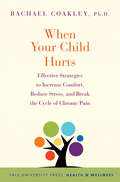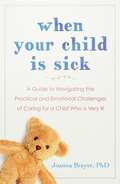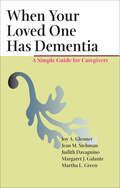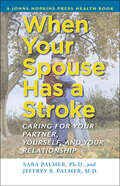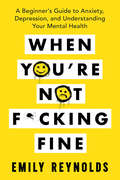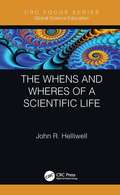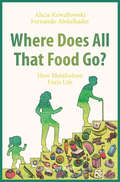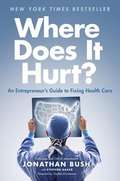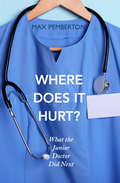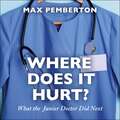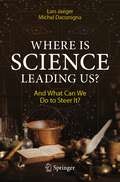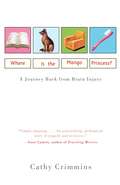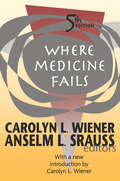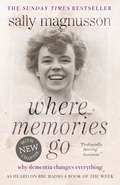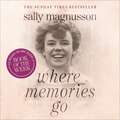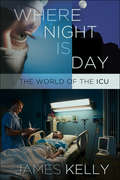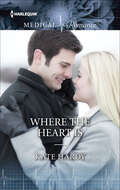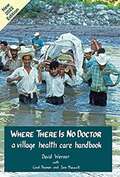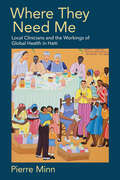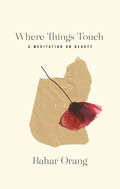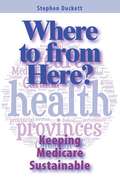- Table View
- List View
When Your Child Hurts
by Rachael CoakleyParents of a child in pain want nothing more than to offer immediate comfort. But a child with chronic or recurring pain requires much more. His or her parents need skills and strategies not only for increasing comfort but also for helping their child deal with an array of pain-related challenges, such as school disruption, sleep disturbance, and difficulties with peers. This essential guide, written by an expert in pediatric pain management, is the practical, accessible, and comprehensive resource that families and caregivers have been awaiting. It offers in-the-moment strategies for managing a child's pain along with expert advice for fostering long-term comfort. Dr. Rachael Coakley, a clinical pediatric psychologist who works exclusively with families of children with chronic or recurrent pain, provides a set of research-proven strategies-some surprisingly counter-intuitive-to achieve positive results quickly and lastingly. Whether the pain is disease-related, the result of an injury or surgery, or caused by another condition or syndrome, this book offers what every parent of a child in pain most needs: effective methods for reversing the cycle of chronic pain. "
When Your Child Is Sick: A Guide to Navigating the Practical and Emotional Challenges of Caring for a Child Who is Very Ill
by Joanna Breyer'Warm, wise and practical' Cressida Cowell, MBEAn invaluable reference for parents of sick or hospitalised children by an experienced and eminent psychologist. To many parents, it is hard to imagine a more upsetting reality than one where their child is hospitalised, severely sick, or terminally ill. In When Your Child is Sick, psychologist Joanna Breyer distils decades of experience working with sick children and their families into a comprehensive guide for navigating the uncharted and frightening terrain. She provides expert advice to guide them through the hospital setting, at-home care, and long-term outcomes.Breyer's actionable techniques and direct advice will help parents feel more in-control of a circumstance that has upended their life. She alerts parents to key personnel in the hospital, gives dialogue prompts to help parents ask for the help they need, addresses the needs of their other children at home, offers advice on how to best utilise friends and family who want to help, includes stories from other families who have been there, and teaches coping techniques to help both parents and children weather the stress of prolonged illness and even death.When Your Child is Sick is a valuable guide to managing the myriad practical and emotional complications of an impossible situation.
When Your Loved One Has Dementia: A Simple Guide for Caregivers
by Joy A. Glenner Jean M. Stehman Judith Davagnino Margaret J. Galante Martha L. GreenEighty percent of persons with dementia live at home, and the family members caring for them are often overwhelmed by the enormous responsibility and the complexities of care. This book is designed to support the caregivers and help them understand the needs and feelings of the person for whom they are caring. A central focus is the goal of sustaining a loving family relationship between the caregiver and the patient. Developed from a training program for professionals and family caregivers, this book teaches the basics of dementia care while emphasizing communication, understanding and acceptance, and personal growth through the caregiving experience. The result is a guide that integrates the practicalities of caregiving with the human emotions that accompany it.
When Your Spouse Has a Stroke: Caring for Your Partner, Yourself, and Your Relationship (A Johns Hopkins Press Health Book)
by Sara Palmer Jeffrey B. PalmerA stroke can alter two people's lives in an instant. For the person who has had a stroke, simple tasks suddenly become difficult or impossible. For that person's partner, life seems to revolve mostly around the stroke survivor's needs. Such a drastic change naturally requires making many, sometimes taxing, adjustments. In this book, two experts in stroke recovery help couples deal with the impact of stroke on their lives and their relationship. Drs. Sara and Jeffrey Palmer explain how to overcome three major challenges:• providing quality care for your partner• maintaining or rebuilding your relationship• caring for yourself as an individualThe book invites you into the lives of real couples who are themselves coping with these challenges. Their experiences model how you can improve essential aspects of your relationship, including communication, roles and responsibilities, and sexuality. A list of practical tips summarizes each chapter, providing a handy reference guide to meeting each day's challenges.More than just a discussion of the medical and practical aspects of stroke and stroke recovery, this book focuses on the emotional, psychological, and social consequences of stroke and the deeply personal side of caregiving. When Your Spouse Has a Stroke will relieve your burden and strengthen your partnership.
When You're Not F*cking Fine: A Beginner's Guide to Anxiety, Depression, and Understanding Your Mental Health
by Emily ReynoldsA mental health guide to stand by you when everything is NOT okayHow do you stay healthy and realistic when you're also dealing with depression, mania, or anxiety? What do you do when, actually, you don't feel f*cking fine? In this blackly funny, deeply compassionate, and extremely practical book, Emily Reynolds gives personal account of what it's like to live with mental illness and the lessons that can help you start your own mental health journey.When You're Not F*cking Fine is a guide for people who know that self-care looks a lot different when you have to fight through your mental illness the whole way. This guide tackles the unique challenges of living with mental illness, anxiety, and depression, including how to:Get the help you need: find a diagnosis and the right treatment planDeal with pressure: manage stress even when you're already at your breaking pointMake time for self-care: kindness for when opening a window or taking out the trash feels impossibleGet on with your life: navigate the world of education, relationships, and expectations without sacrificing your progressWhen You're Not F*cking Fine will help you understand mental illness, deal with it, and make the journey feel a little less lonely.(Previously published as The Beginner's Guide to Losing Your Mind)
The Whens and Wheres of a Scientific Life (Global Science Education)
by John R. HelliwellBig questions and issues arise about the role of the scientific life in our society and in our world. These have to do with trusting science at all, or with the wider roles of the scientist. The Whens and Wheres of a Scientific Life serves as an epilogue to author John R. Helliwell’s scientific life trilogy of books on the Hows (i.e. skills), the Whys and the Whats of a scientific life. When and where questions play a big role in major science facility decisions. When and where also play a big role in controlling a pandemic like the coronavirus COVID-19. The consequences of such work and the role science plays in society are discussed in this book. Key Features: Discusses when and where we can make new and better things happen and make new discoveries. Explains whens and wheres as examples in basic science and explaining these to the public User friendly and concise, this text provides a wide range of examples of science and discovery The author has diverse experience in career development, teaching and research The importance of open data to the reproducibility of science are described
Where Does All That Food Go?: How Metabolism Fuels Life
by Alicia Kowaltowski Fernando AbdulkaderMost of us eat (or incorporate into our bodies) quite a bit of stuff that does not look, act or function even remotely like us. Unless our food mysteriously disappears inside of us, this must mean we change its molecular structure in some way. In fact, we are constantly modifying our molecules through chemical reactions, which together constitute our Metabolism. At any given moment, we transform (metabolize) millions of molecules within our bodies, building new ones, breaking down others, and exchanging them with the world around us. Metabolism is much more than the reason you gain weight when you overeat, it is a process that is so central for life that it defines what a living being is. We will explore what metabolism is, how these chemical reactions that constitute Metabolism are organized and how they are regulated (including the effects of hormones). We will follow the transformations of each type of nutrient (carbohydrates, proteins and lipids) within our bodies and cells, from the mouth, through our intestines and then within the different organs in our body. We will discuss metabolic and evolutionary reasons why so many people today struggle with excessive weight gain, and why some (rarer) people find it hard to gain weight, even when eating large amounts. We will also discuss changes in metabolism with diseases such as diabetes and heart attack, as well as conditions such as exercise and aging.
Where Does It Hurt?: An Entrepreneur's Guide to Fixing Health Care
by Jonathan Bush Stephen BakerA bold new remedy for the sprawling and wasteful health care industry<P> Where else but the doctor's office do you have to fill out a form on a clipboard? Have you noticed that hospital bills are almost unintelligible, except for the absurdly high dollar amount? Why is it that technology in other industries drives prices down, but in health care it's the reverse? And why, in health care, is the customer so often treated as a mere bystander--and an ignorant one at that?<P> The same American medical establishment that saves lives and performs wondrous miracles is also a $2.7 trillion industry in deep dysfunction. And now, with the Affordable Care Act (Obamacare), it is called on to extend full benefits to tens of millions of newly insured. You might think that this would leave us with a bleak choice-- either to devote more of our national budget to health care or to make do with less of it. But there's another path.<P> In this provocative book, Jonathan Bush, cofounder and CEO of athenahealth, calls for a revolution in health care to give customers more choices, freedom, power, and information, and at far lower prices. With humor and a tell-it-likeit- is style, he picks up insights and ideas from his days as an ambulance driver in New Orleans, an army medic, and an entrepreneur launching a birthing start-up in San Diego. In struggling to save that dying business, Bush's team created a software program that eventually became athenahealth, a cloud-based services company that handles electronic medical records, billing, and patient communications for more than fifty thousand medical providers nationwide.<P> Bush calls for disruption of the status quo through new business models, new payment models, and new technologies that give patients more control of their care and enhance the physicianpatient experience. He shows how this is already happening. From birthing centers in Florida to urgent care centers in West Virginia, upstarts are disrupting health care by focusing on efficiency, innovation, and customer service. Bush offers a vision and plan for change while bringing a breakthrough perspective to the debates surrounding Obamacare.<P> You'll learn how:<P> * Well-intended government regulations prop up overpriced incumbents and slow the pace of innovation.<P> * Focused, profit-driven disrupters are chipping away at the dominance of hospitals by offering routine procedures at lower cost.<P> * Scrappy digital start-ups are equipping providers and patients with new apps and technologies to access medical data and take control of care.<P> * Making informed choices about the care we receive and pay for will enable a more humane and satisfying health care system to emerge.<P> Bush's plan calls for Americans not only to demand more from providers but also to accept more responsibility for our health, to weigh risks and make hard choices--in short, to take back control of an industry that is central to our lives and our economy.
Where Does it Hurt?: What the Junior Doctor did next
by Max Pemberton'Treats a grim subject with warmth and self-deprecating good humour ... equally enlightening sequel' Daily MailThe sequel to the bestselling Trust Me, I'm a (Junior) Doctor. The junior doctor is back, but working on the streets for the Phoenix Outreach Project. Unfortunately, his first year in a hospital hasn't quite prepared him for it ...He's into his second year of medicine, but this time Max is out of the wards and onto the streets, working for the Phoenix Outreach Project.Fuelled by tea and more enthusiasm than experience, he attempts to locate and treat a wide and colourful range of patients that somehow his first year on the wards didn't prepare him for . . . from Molly the 80-year-old drugs mule and God in a Tesco car park, to middle-class mums addicted to appearances and pain killers in equal measure.His friends don't approve of the turn his career is taking, his mother is worried and the public spit at him, but Max is determined to make a difference. Despite warnings that miracles are rare, and that not everyone's life can be turned around, Max is still surprised by those that can be saved.Funny, touching and uplifting, Max goes from innocence to experience via dustbin-shopping-trips without ever losing his humanity.
Where Does it Hurt?: What the Junior Doctor did next
by Max Pemberton'Treats a grim subject with warmth and self-deprecating good humour ... equally enlightening sequel' Daily MailThe sequel to the bestselling Trust Me, I'm a (Junior) Doctor. The junior doctor is back, but working on the streets for the Phoenix Outreach Project. Unfortunately, his first year in a hospital hasn't quite prepared him for it ...He's into his second year of medicine, but this time Max is out of the wards and onto the streets, working for the Phoenix Outreach Project.Fuelled by tea and more enthusiasm than experience, he attempts to locate and treat a wide and colourful range of patients that somehow his first year on the wards didn't prepare him for . . . from Molly the 80-year-old drugs mule and God in a Tesco car park, to middle-class mums addicted to appearances and pain killers in equal measure.His friends don't approve of the turn his career is taking, his mother is worried and the public spit at him, but Max is determined to make a difference. Despite warnings that miracles are rare, and that not everyone's life can be turned around, Max is still surprised by those that can be saved.Funny, touching and uplifting, Max goes from innocence to experience via dustbin-shopping-trips without ever losing his humanity.(P) 2020 Hodder & Stoughton Ltd
Where Does Violence Come From?: A Multidimensional Approach to Its Causes and Manifestations
by Bernhard BogertsWhere does violence come from? How can people do such things? These are often the first questions that arise when we witness violence in the in the media or in real life. This book provides comprehensive answers by combining the explanatory approaches from criminology, sociology, psychology, psychiatry, brain research, genetics, pedagogy, historical sciences, and justice into a big, exciting, and comprehensible picture - in an entertaining way with current, state-of-the art science(s). Multiple case studies are presented that show us the frightening diversity of human violence: acts of violence by individual perpetrators; violence between groups; riots and tumults by gangs and hooligans; violent ethnic and religious conflicts; extreme violence in the form of amok and terror; and up to armed conflicts, pogroms, and genocide. Last but not least, the knowledge gained from this book can help answer another big question: how can violence be contained or even prevented? From the contents: How and where does violence originate in our brain?Why has a tendency towards violence become established as part of our behavioural repertoire in the development of humankind?What influences on personality development can lead to violent characters?How often is violence the product of a pathological psyche? Do genes play a role?Which social constellations contribute?What are the causes of rampage and terror?What is known about the relationship between religion and violence?
Where Is Science Leading Us?: And What Can We Do to Steer It?
by Lars Jaeger Michel DacorognaThis book charts the evolution of the sciences and technologies that have shaped our modern age like nothing else in the last 60 years. As well as describing many exciting developments, it will also highlight the challenges and dangers of the technologies that have emerged from them. While science and technology have brought about enormous and often astonishing improvements in our quality of life, they have often also brought with them considerable risks, including the risk of human extinction. We place particular emphasis on the aspects that directly impact us as human beings: Artificial Intelligence (AI), enhancements of our brains/minds through innovative neuro-technologies, and the integration of nanotechnology into our bodies for early disease detection and elimination. What philosophical implications arise from these transformations? Authored by two theoretical physicists who are also experts in economics and capital markets - a rather rare combination - the book will explain the developments of modern science and the resulting technologies. It also examines the current state of play and emerging developments in a manner accessible to non-scientists. Based on their own experience and the analysis, the authors also propose ways in which science can progress more harmoniously in future.
Where Is the Mango Princess? A Journey Back from Brain Injury: A Journey Back From Brain Injury
by Cathy CrimminsHumorist Cathy Crimmins has written a deeply personal, wrenching, and often hilarious account of the effects of traumatic brain injury, not only on the victim, in this case her husband, but on the family.When her husband Alan is injured in a speedboat accident, Cathy Crimmins reluctantly assumes the role of caregiver and learns to cope with the person he has become. No longer the man who loved obscure Japanese cinema and wry humor, Crimmins' husband has emerged from the accident a childlike and unpredictable replica of his former self with a short attention span and a penchant for inane cartoons. Where Is the Mango Princess? is a breathtaking account that explores the very nature of personality--and the complexities of the heart.
Where Medicine Fails (Society Bks.)
by Carolyn L. Wiener Anselm L StraussThis fifth edition of Where Medicine Fails, like previous editions, argues for a broader definition of society's responsibilities to the ill than is commonly perceived to be the case. The authors examine the moral and economic implications of medical technology, especially in regard to fetal tissue transplant, cancer survival, childbirth, and dying, and provide a thoughtful assessment of the issues and challenges facing American hospitals. Seventeen chapters are new to this edition. The aim of this volume is to encourage serious examination of the current structure of health services and of the complicated facets of health care reform.
Where Memories Go: Why dementia changes everything - Now with a new chapter
by Sally MagnussonThis book began as an attempt to hold on to my witty, storytelling mother with the one thing I had to hand. Words. Then, as the enormity of the social crisis my family was part of began to dawn, I wrote with the thought that other forgotten lives might be nudged into the light along with hers. Dementia is one of the greatest social, medical, economic, scientific, philosophical and moral challenges of our times. I am a reporter. It became the biggest story of my life. - Sally Magnusson Regarded as one of the finest journalists of her generation, Mamie Baird Magnusson's whole life was a celebration of words - words that she fought to retain in the grip of a disease which is fast becoming the scourge of the 21st century. Married to writer and broadcaster Magnus Magnusson, they had five children of whom Sally is the eldest. As well as chronicling the anguish, the frustrations and the unexpected laughs and joys that she and her sisters experienced while accompanying their beloved mother on the long dementia road for eight years until her death in 2012, Sally Magnusson seeks understanding from a range of experts and asks penetrating questions about how we treat older people, how we can face one of the greatest social, medical, economic and moral challenges of our times, and what it means to be human. An extraordinary and deeply personal memoir, a manifesto and a call to arms, in one searingly beautiful narrative. Find out more about the book and dementia at Facebook.com/WhereMemoriesGo
Where Memories Go: Why dementia changes everything - Now with a new chapter
by Sally Magnusson'A fine book' The Sunday Times 'Powerful' Guardian 'Wonderful' The Telegraph'Moving, funny, warm' Mail on Sunday'Brave, compassionate, tender and honest' Metro'This book began as an attempt to hold on to my witty, storytelling mother with the one thing I had to hand. Words. Then, as the enormity of the social crisis my family was part of began to dawn, I wrote with the thought that other forgotten lives might be nudged into the light along with hers. Dementia is one of the greatest social, medical, economic, scientific, philosophical and moral challenges of our times. I am a reporter. It became the biggest story of my life.' Sally MagnussonSad and funny, wise and honest, Where Memories Go is a deeply intimate account of insidious losses and unexpected joys in the terrible face of dementia, and a call to arms that challenges us all to think differently about how we care for our loved ones when they need us most.Regarded as one of the finest journalists of her generation, Mamie Baird Magnusson's whole life was a celebration of words - words that she fought to retain in the grip of a disease which is fast becoming the scourge of the 21st century. Married to writer and broadcaster Magnus Magnusson, they had five children of whom Sally is the eldest. As well as chronicling the anguish, the frustrations and the unexpected laughs and joys that she and her sisters experienced while accompanying their beloved mother on the long dementia road for eight years until her death in 2012, Sally Magnusson seeks understanding from a range of experts and asks penetrating questions about how we treat older people, how we can face one of the greatest social, medical, economic and moral challenges of our times, and what it means to be human.Facebook.com/WhereMemoriesGo
Where Memories Go: Why Dementia Changes Everything
by Sally MagnussonThis book began as an attempt to hold on to my witty, storytelling mother with the one thing I had to hand. Words. Then, as the enormity of the social crisis my family was part of began to dawn, I wrote with the thought that other forgotten lives might be nudged into the light along with hers. Dementia is one of the greatest social, medical, economic, scientific, philosophical and moral challenges of our times. I am a reporter. It became the biggest story of my life.Sally MagnussonRegarded as one of the finest journalists of her generation, Mamie Baird Magnusson's whole life was a celebration of words - words that she fought to retain in the grip of a disease which is fast becoming the scourge of the 21st century. Married to writer and broadcaster Magnus Magnusson, they had five children of whom Sally is the eldest. As well as chronicling the anguish, the frustrations and the unexpected laughs and joys that she and her sisters experienced while accompanying their beloved mother on the long dementia road for eight years until her death in 2012, Sally Magnusson seeks understanding from a range of experts and asks penetrating questions about how we treat older people, how we can face one of the greatest social, medical, economic and moral challenges of our times, and what it means to be human.An extraordinary and deeply personal memoir, a manifesto and a call to arms, in one searingly beautiful narrative.Find out more about the book and dementia at Facebook.com/WhereMemoriesGo(P)2014 John Murray Press
Where Night Is Day: The World of the ICU (The Culture and Politics of Health Care Work)
by James Kelly"There is no night in the ICU. There is day, lesser day, then day again. There are rhythms. Every twelve hours: shift change. Report: first all together in the big room, then at the bedside, nurse to nurse. Morning rounds. A group of doctors moves slowly through the unit like a harrow through a field. At each room, like a game, a different one rotates into the center. They leave behind a trail of new orders. Wean, extubate, titrate, start this, stop that, scan, film, scope. The steep hill the patient is asked to climb. Can you breathe on your own? Can you wake up? Can you live?"-from Where Night Is DayWhere Night Is Day is a nonfiction narrative grounded in the day-by-day, hour-by-hour rhythms of an ICU in a teaching hospital in the heart of New Mexico. It takes place over a thirteen-week period, the time of the average rotation of residents through the ICU. It begins in September and ends at Christmas. It is the story of patients and families, suddenly faced with critical illness, who find themselves in the ICU. It describes how they navigate through it and find their way. James Kelly is a sensitive witness to the quiet courage and resourcefulness of ordinary people. Kelly leads the reader into a parallel world: the world of illness. This world, invisible but not hidden, not articulated by but known by the ill, does not readily offer itself to our understanding. In this context, Kelly reflects on the nature of medicine and nursing, on how doctors and nurses see themselves and how they see each other. Drawing on the words of medical historians, doctor-writers, and nursing scholars, as well as the works of James Agee and Michel de Certeau, Kelly examines the relationship of professional and lay observers to the meaning of illness, empathy, caring, and the silence of suffering. As Kelly reflects on the rise of medicine, the theory of nursing, the argument of care versus cure, he offers up an intimate portrait of the ICU and its inhabitants.
Where the Heart Is
by Kate HardyHome…The stunning glacial peaks of Patagonia seem the perfect place for Dr. Rowena Thompson to heal her fragile emotions. When she meets consultant Luke MacKenzie she learns that hers isn't the only heart in need of help.Is where the heart is…Their journey is full of saving lives and challenging emotions, and through it they fi nd a love that neither has experienced before—a love that is tested when Rowena faces a life-changing diagnosis that is familiar to them both. Only if they confront their fears can they face anything, anywhere, as long as they are together.
Where There Is No Doctor: A Village Health Care Handbook
by David B. Werner Carol L. Thuman J. MaxwellHesperian's classic manual, Where There Is No Doctor, is perhaps the most widely-used health care manual in the world. Useful for health workers, clinicians, and others involved in primary health care delivery and health promotion programs, with millions of copies in print in more than 75 languages, the manual provides practical, easily understood information on how to diagnose, treat, and prevent common diseases. Special attention is focused on nutrition, infection and disease prevention, and diagnostic techniques as primary ways to prevent and treat health problems. This 2007 reprint includes new material on preventing the transmission of blood-borne diseases, how HIV/AIDS is reflected in many health issues, and basic Antiretroviral treatment information, as well as updated information on children and aspirin, stomach ulcers, hepatitis, and malaria treatments.
Where There Is No Doctor: A Village Health Care Handbook
by David B. Werner Carol L. Thuman J. MaxwellHesperian's classic manual, Where There Is No Doctor, is arguably the most widely-used health care manual in the world. This 2022 updated reprint features updated medication information, a newly revised family planning chapter, new treatments for a variety of infections, and more. All Hesperian books are regularly updated and reprinted to reflect accurate medical information. Useful for health workers, clinicians, and others involved in primary health care delivery and health promotion programs, with millions of copies in print in more than 75 languages, the manual provides practical, easily understood information on how to diagnose, treat, and prevent common diseases. Special attention is focused on nutrition, infection and disease prevention, and diagnostic techniques as primary ways to prevent and treat health problems.
Where They Need Me: Local Clinicians and the Workings of Global Health in Haiti
by Pierre MinnWhere They Need Me examines the work of Haitian health professionals in humanitarian aid encounters. Haiti is the target of an overwhelming number of internationally funded health projects. While religious institutions sponsor a number of these initiatives, many are implemented within the secular framework of global health. Pierre Minn illustrates the divergent criteria that actors involved in global health use to evaluate interventions' efficacy.Haitian physicians, nurses, and administrative staff are hired to carry out these global health programs, distribute or withhold resources, and produce accounts of interventions' outcomes. In their roles as intermediaries, Haitian clinicians are expected not only to embody the humanitarian projects of foreign funders and care for their impoverished patients but also to act as sources of support for their own kin networks, while negotiating their future prospects in a climate of pronounced scarcity and insecurity. In Where They Need Me, Minn argues that a serious consideration of these local health care providers in the context of global health is essential to counter simplistic depictions of clinicians and patients as heroes, villains, or victims as well as to move beyond the donor-recipient dyad that has dominated theoretical work on humanitarianism and the gift.
Where Things Touch: A Meditation on Beauty (Essais Ser. #10)
by Bahar OrangTo devote oneself to the study of beauty is to offer footnotes to the universe for all the places and all the moments that one observes beauty. I can no longer grab beauty by her wrists and demand articulation or meaning. I can only take account of where things touch.Part lyric essay, part prose poetry, Where Things Touch grapples with the manifold meanings and possibilities of beauty.Drawing on her experiences as a physician-in-training, Orang considers clinical encounters and how they relate to the concept and very idea of beauty. Such considerations lead her to questions about intimacy, queerness, home, memory, love, and other aspects of human existence. Throughout, beauty is ultimately imagined as something inextricably tied to care: the care of lovers, of patients, of art and literature, and the various non-human worlds that surround us.Eloquent and meditative in its approach, beauty, here, beyond base expectations of frivolity and superficiality, is conceived of as a thing to recover. Where Things Touch is an exploration of an essential human pleasure, a necessary freedom by which to challenge what we know of ourselves and the world we inhabit.
Where Things Touch: A Meditation on Beauty (Essais Series #10)
by Bahar OrangTo devote oneself to the study of beauty is to offer footnotes to the universe for all the places and all the moments that one observes beauty. I can no longer grab beauty by her wrists and demand articulation or meaning. I can only take account of where things touch.Part lyric essay, part prose poetry, Where Things Touch grapples with the manifold meanings and possibilities of beauty.Drawing on her experiences as a physician-in-training, Orang considers clinical encounters and how they relate to the concept and very idea of beauty. Such considerations lead her to questions about intimacy, queerness, home, memory, love, and other aspects of human existence. Throughout, beauty is ultimately imagined as something inextricably tied to care: the care of lovers, of patients, of art and literature, and the various non-human worlds that surround us.Eloquent and meditative in its approach, beauty, here, beyond base expectations of frivolity and superficiality, is conceived of as a thing to recover. Where Things Touch is an exploration of an essential human pleasure, a necessary freedom by which to challenge what we know of ourselves and the world we inhabit.
Where to from Here?: Keeping Medicare Sustainable
by Stephen DuckettUniversal healthcare, perhaps the most distinguishing feature of Canada's public policy, is under fire, criticized for its heavy expense and questionable sustainability. In Where to From Here?: Keeping Medicare Sustainable, Stephen Duckett defends Canadian Medicare, addressing key concerns and refuting criticism, while also acknowledging flaws in the system and room for improvement. Duckett argues that while the fundamentals of Medicare are sound, a great deal of change is necessary to keep it sustainable. This book envisions a Medicare that is not static and simply responsive to problems, but an active, shifting system that keeps up with the evolving needs of a rapidly changing time. Duckett systematically lays out proposals for incremental change across a range of areas including primary care, hospitals, and the health workforce. Where to From Here? Presents an unflinching defense of one of Canada's iconic policies, while keeping a clear eye on the future of the nation's health.
